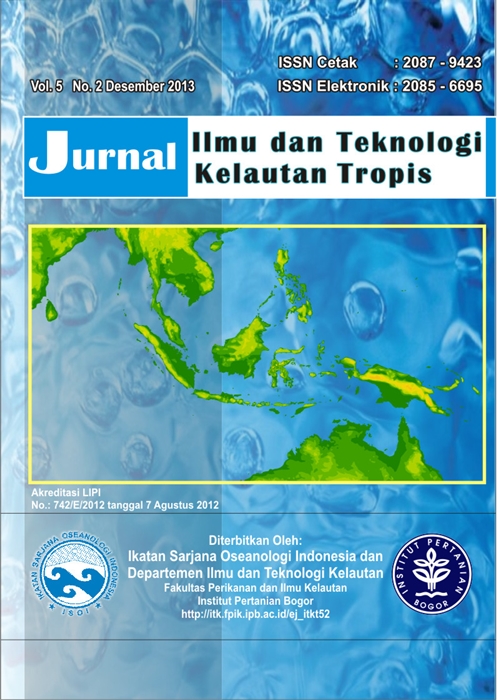SEASONAL SURFACE GEOSTROPHIC CURRENT IN ARAFURA-TIMOR WATERS
Abstract
Research on the seasonal geostrophic surface current during 2002-2011 in Arafura-Timor waters was conducted using satellite altimetry data. Those data were absolute dynamic topography and absolute geostrophic velocity data taken from Archiving Validation and Interpretation of Satellite Oceanographic data (AVISO). The dynamics of geostrophic surface current varied in every monsoon due to the difference in absolute dynamic topography. During northwest (NW) season, the absolut dynamic topography in Arafura Sea was higher than in Timor Sea by an average difference of 0.1–0.2 m and the geostrophic surface current moved from Arafura Sea toward Timor Sea. During southeast (SE) season, the absolute dynamic topography in Arafura Sea lower than Timor Sea with an average difference of 0.03-0.04 m. In this season, upwelling occurs in Banda Sea and sea surface water in this region becomes lower and the current moved from Arafura Sea to Banda Sea. The absolut dynamic topography difference between Arafura Sea and Timor Sea in NW and SE monsoons was 0.05–0.06 m and so the geostrophic surface current moved from Arafura Sea toward Timor Sea. In Timor Sea, the current moved southwest towards the Indian Ocean. In NW and SE Monsoons the the velocity of surface geostrophic current in Timor Sea (0,3 m/sec) was higher compare in Arafura Sea (0.2 m/sec) due to the configuration of island surround the Timor Sea and its topography.
Keywords: Geostrophic surface current, altimetrysatellite, Arafura-Timor Sea
Authors
This work is licensed under a Creative Commons Attribution 4.0 International License.
Jurnal Ilmu dan Teknologi Kelautan Tropis i is an open-access journal, meaning that all content is freely available without charge to the user or their institution. Users are allowed to read, download, copy, distribute, print, search, or link to the full texts of the articles in this journal without needing to request prior permission from the publisher or the author.
All articles published by Jurnal Ilmu dan Teknologi Kelautan Tropis are licensed under the Creative Commons Attribution 4.0 International License. This allows for unrestricted use, distribution, and reproduction in any medium, provided proper credit is given to the original authors.
Authors submitting manuscripts should understand and agree that the copyright of published manuscripts is retained by the authors. Copyright encompasses the exclusive rights of authors to reproduce, distribute, and sell any part of the journal articles in all forms and media. Reproduction of any part of this journal, its storage in databases, and its transmission by any form or media is allowed without written permission from Jurnal Ilmu dan Teknologi Kelautan Tropis.


